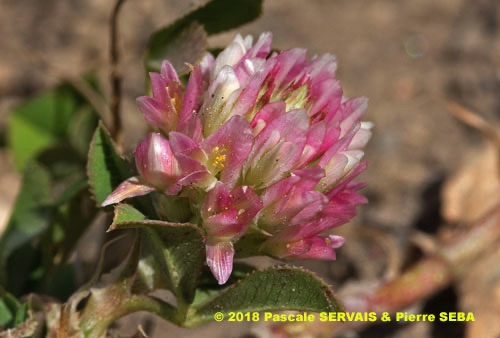
Trifolium petrisavii Clementi
Fam. : Fabaceae
© Pascale SERVAIS & Pierre SEBA, 2018. Tilo Botanica: Flore de Tilos et du Dodécanèse / Flora of Tilos and of the Dodecanese
English translation by Brenda Bradbury, Howard Bradbury and Stéphane Léonard
Plante herbacée, hermaphrodite, étalée à prostrée, à tiges ramifiées à la base, glabres ou peu poilues, rouges dessous et vertes dessus, cylindriques, de ± 2 mm de diamètre.
Feuilles alternes, composées trifoliées, à folioles glabres, entières, bordées d’épines minuscules dirigées vers le sommet, de 7 à 15 mm de long, de 4 à 11 mm de large, à pétiole plus long que le limbe. Stipules brun pourpre à extrémité brusquement rétrécie en longue pointe.
Fleurs à symétrie bilatérale, roses et blanches, de 5 à 6 mm de long, réunies en têtes terminales ± cylindriques, de 10 à 15 mm de diamètre, à pédoncule court. Corolle papilionacée. Bractée jaune pâle à la base de chaque fleur. Calice à 5 sépales soudés, à dents rougeâtres et à nombreuses veines longitudinales. 10 étamines. 1 style beaucoup plus long que l’ovaire et 1 stigmate. Ovaire supère.
Fruits, gousses droites à style persistant, ovoïdes, glabres, de 1 mm de diamètre, entourée par la corolle devenue brune et rigide à la fructification.
___________________________
Plant herbaceous, hermaphrodite, spread out to prostrate. Stems branched at the base, glabrous or not very hairy, red below and green above, cylindrical, ± 2 mm in diameter.
Leaves alternate, compound trifoliate, with glabrous, entire leaflets, bordered by tiny thorns directed towards the top, from 7 to 15 mm long, from 4 to 11 mm across, with petiole longer than the blade. Stipules purple brown with tip abruptly narrowed in long point.
Flowers bilaterally symmetrical, pink and white, from 5 to 6 mm long, joined together in terminal, ± cylindrical heads, from 10 to 15 mm in diameter, with short peduncle. Corolla papilionaceous. Pale yellow bract at the base of each flower. Calyx with 5 fused sepals, with reddish teeth and with numerous longitudinal veins. 10 stamens. 1 style much longer than the ovary and 1 stigma. Ovary superior.
Fruits, straight pods with persistent style, ovoid, glabrous, 1 mm in diameter, surrounded by the corolla turning brown and rigid at fructification.
Descripteurs / Identifying features
1
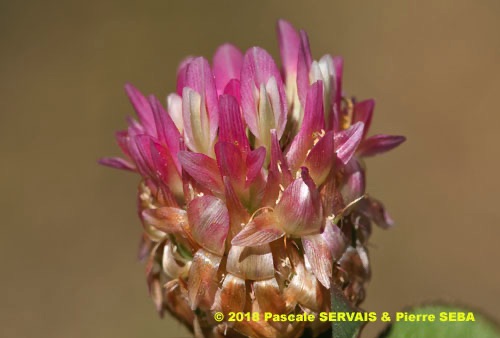
2
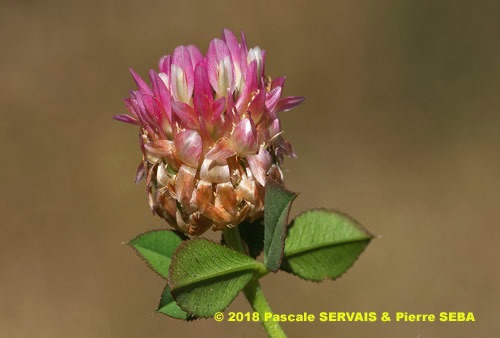
3
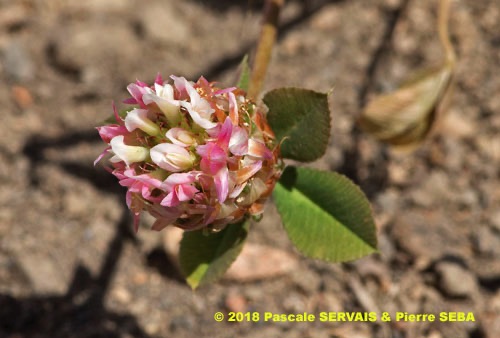
4
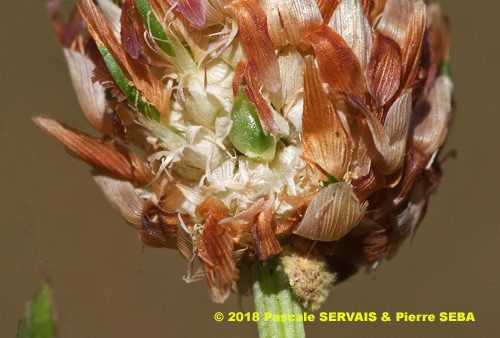
5
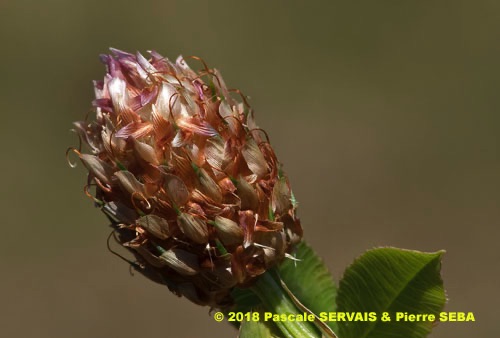
6
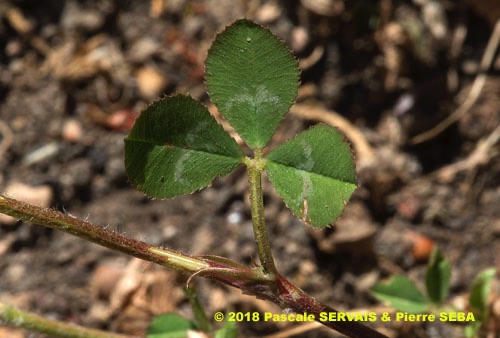
7
Étymologie / Etymology :
Trifolium : emprunt du latin trifolium, -i (nom) [ < tres (adj.) = trois
+ folium, -i (nom) = la feuille ] = le trèfle, nom donné à la plante par
Pline, naturaliste latin mort en 79 apr. J.-C., en référence aux feuilles
à trois folioles caractéristiques.
Petrisavii : nom donné en l’honneur de Pietro Savi (1811-1871),
professeur de botanique et directeur du Jardin Botanique de
l’Université de Pise.
Trifolium : borrowed from Latin trifolium, -i (noun) [ < tres (adj) = three
+ folium, -i (noun) = leaf ] = clover, name given to the plant by Plinius,
Latin naturalist died in 79 AD, referring to the leaves with three
characteristic leaflets.
Petrisavii : name given in honour of Pietro Savi (1811-1871),
professor of botany and director of the Botanical Garden of Pisa.
Synonymes / Synonyms :
Trifolium nigrescens subsp. petrisavii (Clementi) Holmboe
Trifolium meneghinianum Clementi
Noms vernaculaires / Common names :
Nom français / French name :
Trèfle de Pietro Savi.
Nom anglais / English name :
Petrisavis clover.
Nom allemand / German name :
Petrisavis Klee.
Habitat :
Prairies - Lieux incultes - Chemins.
Meadows - Waste ground - Waysides.
Île / Island :
Tilos.
Hauteur / Height range :
De 5 cm à 20 cm.
From 5 cm to 20 cm.
Floraison / Flowering time :
De mars à mai.
From March to May.
Groupe / Classification :
Dicotylédones.
Dicotyledons.
Pérennité / Lifespan :
Annuelle.
Annual.
Description :
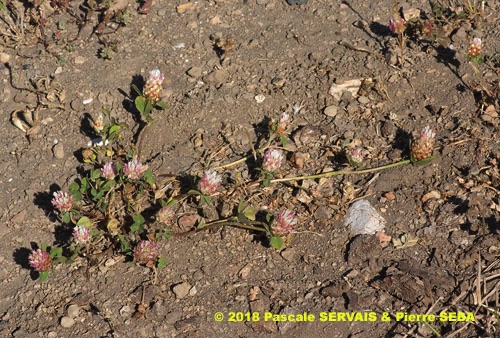
8
Clés dichotomiques et descripteurs distinctifs des 15 espèces / Dichotomous keys and distinctive identifying features of the 15 species
Photo 1 :
Localisation / Location : Tilos, Megalochorio, Plaine d’Erystos
Date : 22/04/2018
GPS : Lat. 36,44513° N / Long. 27,34585° E / Alt. 38 m
Type : Photographie numérique / Digital Photograph (24 mégapixels)
Photo 2 :
Localisation / Location : Tilos, Megalochorio, Plaine d’Erystos
Date : 22/04/2018
GPS : Lat. 36,44513° N / Long. 27,34585° E / Alt. 38 m
Type : Photographie numérique / Digital Photograph (24 mégapixels)
Photo 3 :
Localisation / Location : Tilos, Megalochorio, Plaine d’Erystos
Date : 22/04/2018
GPS : Lat. 36,44513° N / Long. 27,34585° E / Alt. 38 m
Type : Photographie numérique / Digital Photograph (24 mégapixels)
Photo 4 :
Localisation / Location : Tilos, Megalochorio, Plaine d’Erystos
Date : 22/04/2018
GPS : Lat. 36,44513° N / Long. 27,34585° E / Alt. 38 m
Type : Photographie numérique / Digital Photograph (24 mégapixels)
Photo 5 :
Localisation / Location : Tilos, Megalochorio, Plaine d’Erystos
Date : 22/04/2018
GPS : Lat. 36,44513° N / Long. 27,34585° E / Alt. 38 m
Type : Photographie numérique / Digital Photograph (24 mégapixels)
Photo 6 :
Localisation / Location : Tilos, Megalochorio, Plaine d’Erystos
Date : 22/04/2018
GPS : Lat. 36,44513° N / Long. 27,34585° E / Alt. 38 m
Type : Photographie numérique / Digital Photograph (24 mégapixels)
Photo 7 :
Localisation / Location : Tilos, Megalochorio, Plaine d’Erystos
Date : 22/04/2018
GPS : Lat. 36,44513° N / Long. 27,34585° E / Alt. 38 m
Type : Photographie numérique / Digital Photograph (24 mégapixels)
Photo 8 :
Localisation / Location : Tilos, Megalochorio, Plaine d’Erystos
Date : 21/04/2018
GPS : Lat. 36,44513° N / Long. 27,34585° E / Alt. 38 m
Type : Photographie numérique / Digital Photograph (24 mégapixels)

Google Maps
Google Maps
Google Maps
Google Maps
Google Maps
Google Maps
Google Maps
Google Maps